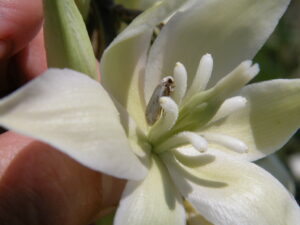By Wren Smith
As children, it’s the little things that we often notice: the ants parading through a jungle of grasses, a caterpillar munching on a leaf or a spider waiting for her dinner. Taking delight in the small details of nature can illuminate the remarkable inter-connectiveness of life and bring a bigger picture into focus. Even as a child, I was awe struck but the beauty in the web of life.
 In summer, our fields, forest, and gardens are alive with this great hum of life emanating from bees, butterflies, and other miniature marvels. With some flowering plants, the connection between the tiny world of insects is obvious, but with others it can be a bit more hidden.
In summer, our fields, forest, and gardens are alive with this great hum of life emanating from bees, butterflies, and other miniature marvels. With some flowering plants, the connection between the tiny world of insects is obvious, but with others it can be a bit more hidden.
Take yucca plants, for instance. You might be surprised to learn that yucca is related to the Joshua Trees of the west. Our species, Yucca filamentosa, is appropriately named with its long thread-like filaments. These filaments are tough enough that they have been used by Native Americans for making cordage and even a cloth-like material. But the hidden strength of these fibers is not the only secrets hidden in these plants.
Hidden in their lovely bell-like flowers are diminutive moths, Pronuba yuccasella, which have a special symbiotic relationship with yucca. The yucca moth gathers pollen from the anthers of one blossom and packs it into a little ball beneath her head. She then flies to another flower, climbs up the style, rams the pollen packet deep into the stigma of the flower. She then travels down the style and lays an egg at the base. Although many other insects visit the yucca blossoms, only the yucca moth, which seems deliberate in its effort at pollination, succeeds and ensures that when her young hatch, they will have a ready food supply. The yucca moth usually lays no more than 6 eggs per flower, insuring that her young won’t eat all the seeds and damage the long term future of both yuccas and moths.
When you visit places like Bernheim, be sure to stop and notice the little things (and creatures) that connect us.

